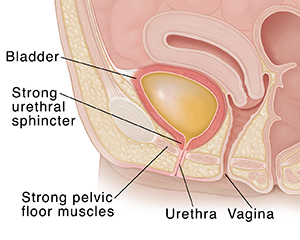What Is Stress Urinary Incontinence (SUI)?
What Is Stress Urinary Incontinence?
Stress urinary incontinence is a common type of bladder control problem in women (although it may also occur in men). It refers to leakage of urine during events that result in increased abdominal pressure, such as sneezing, coughing, physical exercise, lifting, bending, and even changing positions. Stress incontinence may occur when the structures that help hold urine in your bladder become weak.
What are the symptoms of stress incontinence?
If you have stress incontinence, you may leak urine when you:
Cough, sneeze, or laugh
Lift something heavy
Exercise
Normal urine control
The bladder holds urine until you are ready to let it flow out. These structures help:
The pelvic floor muscles and connective tissue help hold the pelvic organs in place. When the muscles and connective tissue are strong, the urethra and bladder are well supported. This helps keep the urethra closed, so urine doesn’t leak.
The urethral sphincter is a band of muscles around the urethra. When these muscles are strong, they keep urine in the bladder. These muscles relax when you want urine to flow out.
If urine leaks out
The pelvic floor muscles and connective tissue may stretch, weaken, or tear. Weak or torn structures can’t support the urethra and bladder. The urethral sphincter may also weaken. These changes can cause urine to leak. The changes may be caused by:
Pregnancy and vaginal childbirth or C-section (surgery to deliver a baby)
Constant coughing (such as with bronchitis or chronic cough from smoking)
Being overweight or obese
Hysterectomy or other pelvic surgery
Nerve damage
Treatment
Different treatments are available for stress incontinence including:
Lifestyle changes such as reducing weight, quitting smoking, reducing drinks with caffeine or alcohol and bladder strengthening exercises
Surgery of various types
Various medical devices such as pessaries
Updated:
March 21, 2017
Reviewed By:
Greenstein, Marc, DO,Hanrahan, John, MD,Image reviewed by StayWell medical illustration team.

